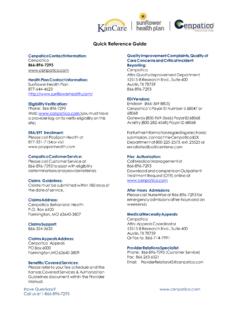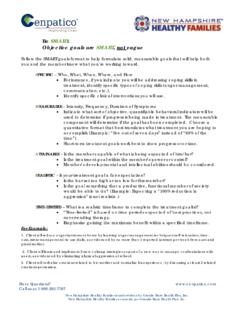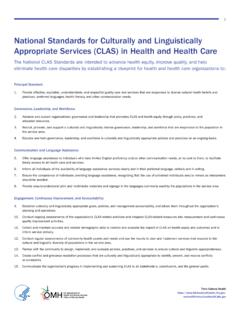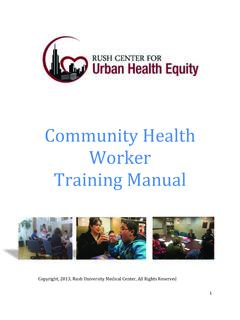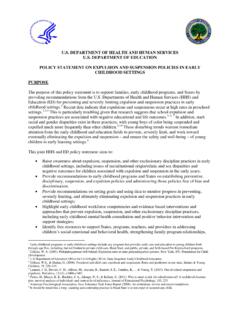Transcription of Cultural Issues in DSM-5: Outline for Cultural Formulation ...
1 Cultural Issues in DSM-5: Outline for Cultural Formulation (OCF) and Cultural Formulation Interview (CFI). American Association of Directors of Psychiatric Residency Training Annual Meeting March 14, 2014. Tucson, AZ. PRESENTERS. Russell F. Lim, MD, MEd health Sciences Clinical Professor University of California, Davis Department of Psychiatry and Behavioral Sciences Francis G. Lu, MD. Luke and Grace Kim Professor of Cultural Psychiatry Emeritus, University of California, Davis Department of Psychiatry and Behavioral Sciences Roberto Lewis-Fern ndez, MD. Professor of Clinical Psychiatry Columbia University Financial Disclosures Dr. Lim is the editor of The Clinical Manual of Cultural Psychiatry, 2nd edition, APPI, in press. Dr. Lu has no disclosures. Dr. Mills has no disclosures. Outline Definitions and rationale Overview of Cultural Issues in DSM-5. DSM-5 Outline for Cultural Formulation (OCF).
2 DSM-5 Cultural Formulation Interview (CFI). Objectives - 1. 1) Describe the five parts of the Outline for Cultural Formulation (OCF). 2) Use the 16 questions of the Cultural Formulation Interview (CFI) to conduct an interview to elicit Cultural Issues described by the OCF: - Cultural identity - Cultural concepts of distress - Cultural stressors and supports - Cultural features of the clinician-individual relationship Objectives - 2. 3) Be familiar with the use of the 12. supplementary modules when appropriate. 4) Be able to formulate a case using the DSM-5 Outline for Cultural Formulation (OCF). Cultural Competence . A set of congruent behaviors, attitudes, and policies that come together in a system, agency, or among professionals that enable them to work effectively in cross- Cultural situations. (Terry Cross, et al, 1989). added Linguistic Competence . Cultural Competence (Joint Commission, 2010).
3 The ability of health care providers and health care organizations to understand and respond effectively to the Cultural and language needs brought by the patient to the health care encounter.. Cultural Competence : Essential Elements of the Journey Self assessment about one's own Cultural identity, values, prejudices, biases, etc. Humility about the limits of one's assessment and treatment knowledge/skills Valuing diversity via awareness of and sensitivity to Cultural differences Vigilance towards the power dynamics that result from Cultural differences Responsiveness to Cultural differences via adaptation of assessment and treatment Improve Quality Indicators of health Care: Institute of Medicine, 2001. ( ). 6 Quality outcomes as goals Safe: avoiding injuries to patients from the care that is intended to help them. Effective: providing services based on scientific knowledge to all who could benefit, and refraining from providing services to those not likely to benefit.
4 Patient-centered: providing care that is respectful of and responsive to individual patient preferences, needs, and values, and ensuring that patient values guide all clinical decisions. [Culturally/linguistically competent]. 6 Quality outcomes as goals Timely: reducing waits and sometimes harmful delays for both those who receive and those who give care. Efficient: avoiding waste, including waste of equipment, supplies, ideas, and energy. Equitable: providing care that does not vary in quality because of personal characteristics such as gender, ethnicity, geographic location, and socioeconomic status. [Eliminating disparities ]. Unequal Treatment: Confronting Racial and Ethnic disparities In health Care Controlling for income, insurance status, age, severity of illness, racial/ethnic minorities receive lower quality health care - IOM, 2002. Differences, disparities , and Discrimination: Populations with Equal Access to health Care Clinical Appropriateness and Need Patient Prefs.
5 Non-Minority Difference The Operation of Healthcare Systems and the Legal and Regulatory Climate Disparity Minority Discrimination: Biases and Prejudice, Stereotyping, and Uncertainty Populations with Equal Access to health Care Evidence of Racial and Ethnic disparities in Healthcare disparities are consistently found across a wide range of disease areas and clinical services. disparities in care are associated with higher mortality among minorities ( , Bach et al., 1999; Peterson et al., 1997;. Bennett et al., 1995). Clinical Encounter Factors Contributing to disparities Bias (prejudice) some evidence suggests that unconscious biases may exist. Clinical uncertainty a plausible hypothesis, particularly when providers treat patients that are dissimilar in Cultural or linguistic background. Stereotyping evidence suggests that physicians, like everyone else, use these cognitive shortcuts.
6 '. Biases: Intended/Conscious or Unintended/Unconscious Racism Bias against immigrants/refugees Sexism Classism Ageism Homophobia Bias against religion/spirituality or certain beliefs/practices Other biases MENTAL health : CULTURE, RACE, AND ETHNICITY. (USDHHS-Office of the Surgeon General, 2001). Striking disparities in mental health care are found for racial and ethnic minorities Minorities have less access to, and availability of, mental health services. Minorities are less likely to receive needed mental health services. Minorities in treatment often receive a poorer quality of mental health care. Minorities are underrepresented in mental health research. These disparities create an increased disability burden for racial/ethnic minorities. disparities in Psychiatric Care, Ruiz and Primm (eds.), 2009. Racial/ethnic minorities Women LGBT. Incarcerated Chronically mentally ill Dual diagnosed Rural areas Disabled More 6/25/2014.
7 19. Summary: disparities and Cultural Competence in Mental health disparities in mental heath care for ethnic minorities and other underserved populations exist and should be eliminated. Cultural and linguistic competence will reduce disparities . Systems at the organization level Clinical at the individual provider level Cultural Issues in DSM-5. Section 1: Introduction: Cultural Issues . and Gender Differences (p. 14-15). Section 2: Disorder narrative sections: Culture-Related Diagnostic Issues (index p. 923-924). Gender-Related Diagnostic Issues Diagnostic criteria (some disorders). Other Conditions Cultural Issues in DSM-5. Section 3. Outline for Cultural Formulation (OCF) revised from DSM-IV/-IV-TR. Cultural Formulation Interview (CFI). Appendix Glossary of Cultural Concepts of Distress replacing Glossary of Culture-Bound Syndromes Introduction: DSM-5 definition of culture Values, orientations, knowledge, and practices that individuals use to understand their experiences, based on their identification with diverse groups, such as: Ethnic groups, faith communities, occupational groups, veterans, etc.
8 Aspects of a person's background, experience, and social contexts that may affect his or her perspective, such as: Geographical origin, migration, language, religion, sexual orientation, race/ethnicity, etc. The influence of family, friends, and other community members (the individual's social network) on the individual's illness experience Culture in mental health Culture is NOT ONLY geographic origin, race or ethnicity. Culture is dynamic, not static. Cultural identity varies from person to person. Cultural Competence refers to the ability of mental health professionals and services to provide person-centered care to patients by taking into account the multiple, ever-changing, and highly individualized Cultural identities of each person receiving services. Schizophrenia - 1. Culture-Related Diagnostic Issues : Cultural and socioeconomic factors must be considered, particularly when the individual and the clinician do not share the same Cultural and socioeconomic background.
9 Ideas that appear to be delusional in one culture ( , witchcraft) may be commonly held in another.. Schizophrenia - 2. In some cultures, visual or auditory hallucinations with a religious content ( , hearing God's voice) are a normal part of religious experiences .In certain cultures, distress may take the form of hallucinations or pseudo-hallucinations and overvalued ideas that may present clinically similar to true psychosis but are normative to the patient's subgroup.. (p. 103). Panic Disorder Culture-Related Diagnostic Issues : Cultural variations in onset, severity, symptom expression Relationship to Cultural concepts of distress (Ataque de nervios, Khyal cap Diagnostic Criteria change: Culture- specific symptoms ( , tinnitus, neck soreness, headache, uncontrollable screaming or crying) may be seen. Such symptoms should not count as one of the four required symptoms.)
10 Other Conditions That May be a Focus of Clinical Attention (V Codes). The conditions and problems listed in this chapter are not mental disorders.. (p. 715). Relational Problems Abuse and Neglect Educational and Occupational Problems Housing and Economic Problems 5 additional areas Religious or Spiritual Problem This category can be used when the focus of clinical attention is a religious or spiritual problem. Examples include distressing experiences that involve loss or questioning of faith, problems associated with conversion to a new faith, or questioning of other spiritual values which may not necessarily be related to an organized church or religious institution. (p. 725). Acculturation Difficulty This category should be used when difficulty in adjusting to a new culture ( , following migration) is the focus of clinical attention or has an impact on the individual's treatment or prognosis.
